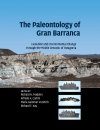About this book
Gran Barranca in Patagonia exposes the most complete sequence of middle Cenozoic paleofaunas in South America. It is the only continuous continental fossil record of the Southern Hemisphere between 42 and 18 million years ago, when climates at high latitudes transitioned from warm humid to cold dry conditions.
The Paleontology of Gran Barranca presents the geochronology of the fossil mammal sequence and a compilation of the latest studies of the stratigraphy, sedimentology, mammals, plants, invertebrates and trace fossils. It is also the first detailed treatment of the vertebrate faunal sequence at Gran Barranca, providing important new evidence about biotic diversity and evolution in the native species.
A revised taxonomy allows a reevaluation of the origination and extinction of herbivorous mammals, marsupials and xenarthrans, and the earliest occurrence of rodents and primates in southern latitudes.
Contents
Preface
List of contributors
1. Notes toward a history of vertebrate paleontology at Gran Barranca
Part I. Geology
2. Physical stratigraphy of the Sarmiento Formation (middle Eocene - lower Miocene) at Gran Barranca, central Patagonia
3. Paleomagnetism and magnetostratigraphy of the Sarmiento Formation (Eocene-Miocene) at Gran Barranca, Chubut, Argentina
4. A geochronology for the Sarmiento Formation at Gran Barranca
Part II. Systematic Palaeontology
5. Middle Eocene - Oligocene gastropods of the Sarmiento Formation, central Patagonia
6. Middle Tertiary marsupials from central Patagonia (early Oligocene of Gran Barranca): understanding South America's Grande Coupure
7. Middle Eocene - Early Miocene Dasypodidae (Xenarthra) of southern South America: biostratigraphy and palaeoecology
8. The 'Condylarth' Didolodontidae from Gran Barranca: history of the bunodont South American mammals until the Eocene-Oligocene transition
9. The Notohippidae (Mammalia, Notoungulata) from Gran Barranca: preliminary considerations
10. Rodent-like notoungulates (Typotheria) from Gran Barranca, Chubut Province, Argentina: phylogeny and systematics
11. The Leontiniidae (Mammalia, Notoungulata) from the Sarmiento Formation at Gran Barranca, Chubut Province, Argentina
12. Colhuehuapian Astrapotheriidae (Mammalia) from Gran Barranca south of Lake Colhue Huapi
13. The rodents from La Cantera and the early evolution of caviomorphs in South America
14. Colhuehuapian rodents from Gran Barranca and other Patagonian localities: the state of the art
15. A new primate from the early Miocene of Gran Barranca, Chubut Province, Argentina: paleoecological implications
16. Bats (Mammalia: Chiroptera) from Gran Barranca (early Miocene, Colhuehuapian), Chubut Province, Argentina
Part III. Patterns of Evolution and Environmental Change
17. The Mustersan age at Gran Barranca: a review
18. A new mammal fauna at the top of the Gran Barranca sequence and its biochronological significance
19. Loessic and fluvial sedimentation in Sarmiento Formation pyroclastics,middle Cenozoic of central Patagonia
20. Paleosols of the Middle Cenozoic Sarmiento Formation, central Patagonia
21. Ichnofacies analysis of the Sarmiento Formation (middle Eocene-early Miocene) at Gran Barranca, central Patagonia
22. Phytolith studies in Gran Barranca (central Patagonia, Argentina), the middle-late Eocene
23. Stable isotopes of fossil teeth and bones at Gran Barranca as a monitor of climate change and tectonics
24. Hypsodonty and body size in rodent like notoungulates
Part IV. Regional Applications
25. Vegetation during the Eocene-Miocene interval in central Patagonia: a context of mammal evolution
26. Paleogene climatic and biotic events in the terrestrial record of the Antarctic Peninsula: an overview
27. Mid-Cenozoic palaeoclimatic and palaeoceanographic trends in the southwestern Atlantic basins, a dinoflagellate view
28. Divisaderan land mammal age or local fauna?
29. Gran Barranca: a twenty-three million year record of Middle-Cenozoic faunal evolution in Patagonia
Index
Customer Reviews
Biography
Richard H. Madden has been a Research Associate at the Duke University Medical Center for the last 20 years where he assists in the teaching of anatomy in the School of Medicine. Alfredo A. Carlini is a Research Paleontologist of CONICET and Professor of Comparative Anatomy at the National University of La Plata, Argentina. Maria Guiomar Vucetich is a Research Palaeontologist of CONICET (Consejo Nacional de Investigaciones Cientificas y Tecnicas) and Professor of Vertebrate Palaeontology at the National University of La Plata, Argentina, where she has worked since 1971. Richard F. Kay is Professor of Evolutionary Anthropology, and Earth and Ocean Sciences at Duke University, North Carolina, where he has worked since 1973.
























![Pravěký Svět Zdeňka Buriana, Kniha 2: Monstra Třetihor a Čtvrtohor [The Prehistoric World of Zdeněk Burian, Volume 2: Tertiary and Quaternary Monsters]](http://mediacdn.nhbs.com/jackets/jackets_resizer_medium/26/263198.jpg?height=150&width=108)











